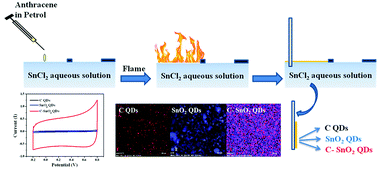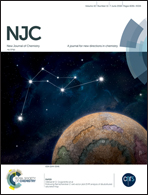A composite thin film of simultaneously formed carbon and SnO2 QDs for supercapacitor application†
Abstract
A uniform size and structure of a composite material are critical assets that determine the properties, such as charge transfer, thermal, photoluminescence, mechanical, etc., and consequently the applications of the material; herein, we report the concept of flame/combustion at a liquid–liquid interface for the first time to synthesize in situ a thin film of a composite consisting of two or more quantum dots. The synthesis of the thin films of a composite containing C and SnO2 QDs having particle sizes below 2 nm was successfully carried out. As compared to single quantum dot systems, the formed composite showed significantly improved specific capacitance due to the synergistic effect arising from the strong interaction between C and SnO2 QDs. This was confirmed by XPS, and UV visible spectroscopy. Moreover, it was confirmed that even after 1000 charge/discharge cycles, the interaction between C and Sn remained unaltered; this indicated significant stability of the capacitance. Some of the advantages of this method include a one-step eco-friendly process and use of ambient conditions. The generality of the method was established by synthesizing C–ZnO and C–TiO2 composite thin films. This new approach can be extended to form many other valuable composite thin films for various applications.



 Please wait while we load your content...
Please wait while we load your content...